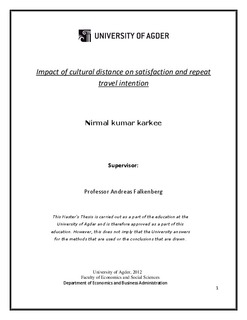| dc.contributor.author | Karkee, Nirmal Kumar | |
| dc.date.accessioned | 2012-11-28T08:11:48Z | |
| dc.date.available | 2012-11-28T08:11:48Z | |
| dc.date.issued | 2012 | |
| dc.identifier.uri | http://hdl.handle.net/11250/135724 | |
| dc.description | Masteroppgave i økonomi og administrasjon - Universitetet i Agder 2012 | no_NO |
| dc.description.abstract | Cultural difference and tourism are interlinked with each other due to their obvious association and their potential in the growth of destination. Cultural difference has a real impact on tourist satisfaction and intension to repeat travel. Cultural tourism is one of the major and fastest rising international tourism markets and the cultural and heritage industries are increasingly promoting their destinations by the use of cultural attributes. The multiplying use of cultural resources and inventiveness to promote destinations is also increasing pressure of differentiating local culture and images. As a result increasing range of cultural resources are being used to brand and market regions.
Nepal is situated between China and India and is a landlocked Himalayan country. Nepal has a very rich tourism industry which consists of its ethereal mountain scenery. It also has a lot of religious places and Hindu and Buddhist religious practices. A large number of people living in Nepal are involved in tourism industry. The tourism in Nepal is considered as the largest tourist industry of the Himalayan country.
Nepal is very blessed in terms of its culture. Its culture is considered as one of the richest cultures of the world. Culture represents the way of life of a society or nation. This definition holds predominantly true in case of Nepal where every feature of life including the dresses, food and even professions are culturally guided.
In this research we aimed to find the impact of cultural distance on overall satisfaction of the people with the tour and the intention of repeat travel. We first analyzed the impact of cultural distance on the overall satisfaction of people with the tour. As we included people from all parts of the world visiting Nepal, there was a huge cultural distance between the Nepal and the tourists who were included in our study.
We found the cultural difference was positively correlated with the satisfaction of the touruists visiting Nepal. This means that cultural difference increases the overall satisfaction of tourist visiting a different cultural place.
Secondly we analyzed the impact of cultural distance on the intention of the tourists to repeat travel. We found a positive correlation between these two variables. We found that cultural differences play a positive role in the intention of repeat travel of the tourist to the same place.
We can conclude that cultural difference is a main driving force which is driving people from all parts of the world to Nepal to see cultural places of Nepal. Tourists also visit Nepal because they like to take part in different cultural activities in Nepal which are new to them and they cannot enjoy these cultural activities and festivals in their native countries. | no_NO |
| dc.language.iso | eng | no_NO |
| dc.publisher | Universitetet i Agder ; University of Agder | no_NO |
| dc.subject.classification | BE 501 | |
| dc.title | Impact of cultural distance on satisfaction and repeat travel intention | no_NO |
| dc.type | Master thesis | no_NO |
| dc.subject.nsi | VDP::Social science: 200::Political science and organizational theory: 240::Public and private administration: 242 | no_NO |
| dc.source.pagenumber | 76 s. | no_NO |
